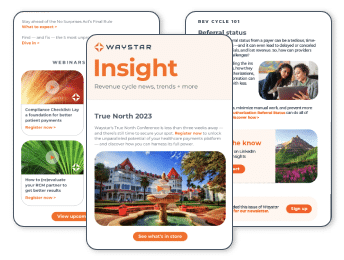The Centers for Medicare & Medicaid Services (CMS) is continuing work to finalize the No Surprises Act with its announcement of a third proposed rule with a 60-day comment period. The rules outline operating procedures for the independent resolution process, good faith estimates requirements for uninsured patients, and policies for dispute resolution. All three rules under the law are scheduled to become effective on Jan. 1, 2022.
On December 27, 2020, Congress passed the No Surprise Act as part of the Consolidated Appropriations Act, 2021. The law is in response to dissatisfaction among patients, providers, and insurers about longstanding complaints about medical bills. According to a 2020 U.S. Bank Healthcare Payments Insight Report, the decades-old system of paper EOBs and mail collections is prime for an update.
- 40% said they had been surprised by an unexpected medical bill.
- 67% of consumers worry they won’t be able to afford a surprise medical bill.
- 70% report healthcare payments are more difficult than in other sectors.
Such discontent also creates labor-intensive inefficiencies for providers and insurance companies to respond to patients upset over their medical bills.
Highlights of the rule proposal
In its coverage of the CMS announcement, industry source Becker’s Healthcare cited a dozen critical points of the latest proposed rule. These included:
- Providers and Insurers have 30 days for an “open negotiation” period. If no agreement is reached, the parties may initiate an independent resolution process. As part of the announcement, CMS also announced a new website for organizations to become a Certified Independent Dispute Resolution Entity (IDR). If the designated IDR cannot resolve the matter, CMS will render a final decision.
- Providers will be required to provide good faith estimates to uninsured and self-pay patients. Such estimates must include “reasonably expected” charges, including if care is provided by another provider or facility.
- A patient may initiate a resolution under the No Surprise Act if charges are more than $400 of an estimate, which is a per-provider and/or per-facility threshold. The resolution must be filed within 120 days of a patient receiving their medical bill.
- CMS has expanded its authority to review a resolution complaint. The intent is to monitor overall compliance with the No Surprises Act.
- IDR certifications can be revoked. Providers, facilities, air ambulance services, health plans, and members of the public can initiate a denial or revocation of an IDR entity.
Why patients often get surprise bills at in-network hospitals
The No Surprises Act rollout is another nudge for hospitals and other providers to reinvent the patient pricing and payment experience to diminish cost fear. The legislation includes language that pertains to providers who are out-of-network (OON) for a patient’s coverage and the billing complications that situation can create.
The current OON practice calls for patients to be billed the difference between gross charges and an insurance company’s OON payment. This can add up to an out-of-pocket cost that’s much higher than expected, often due to the lack of an in-network discount compounded by an insurance company assessing OON benefits.
Such “balance billing” is often unexpected or a surprise — hence the name of the act. Balance billing is often associated with an emergency room visit or in the surgical suite when a contracted physician such as an anesthesiologist does not participate in a patient’s insurance plan.
CMS cited a recent study that found about 40% of emergency department visits to in-network hospitals result in surprise charges due to contracted physician staffing. CMS has also noted that OON cost share with balance billing can be ten times higher than an in-network cost share for the same service.
How providers benefit from a ‘No Surprises’ patient experience
As providers implement new solutions to prepare for the No Surprises Act, they stand to gain more than just a reduction in surprise bills. These tools also create more productive workflows and strengthen the potential for reimbursement through automated and digital cost estimates coupled with effective payment alternatives.
- A 2018 industry study found that when patients are satisfied with their billing experience, they will pay their bills 75% of the time. This compares to only 50% when they have a bad experience with the business office.
- A 2021 survey indicated that consumers favor health systems that provide accurate online, digital cost estimates. Of those surveyed, 62% said knowing their out-of-pocket obligation in advance impacts their likelihood of seeking care. Also, 49% said “clear” information impacts their decision to choose a healthcare provider.
In order to comply with the guidelines set out in the No Suprises Act, health systems and other providers should proactively optimize their patient financial experience, evaluate the tech they already have in place and update accordingly in order to deliver more accurate patient estimates. Taking the proactive approach ensures not just more reliable reimbursement, but a more supportive environment that helps patients better manage their fiscal responsibility.
Find this post helpful? Check out our guide to providing automated estimates for better financial counseling.


